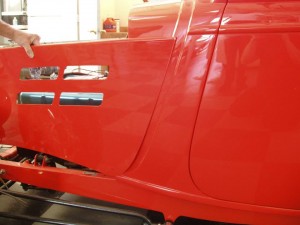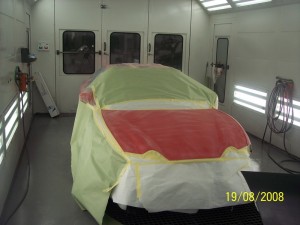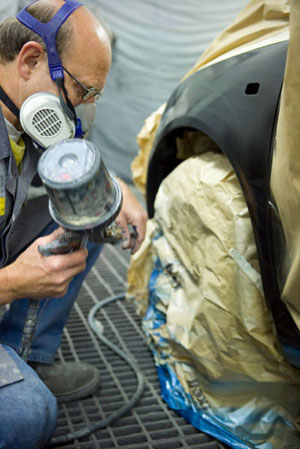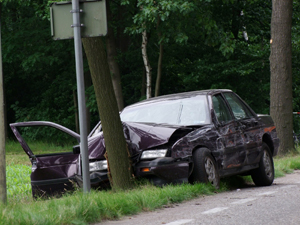For answers to common questions about painting problems, click here.
For answers to common Collision Center business questions, click here.
I’m thinking about switching to Waterborne. What do I need to know?
Show Answer »
Click here to view answers to some FAQ’s about waterborne. PPG wants to make sure that your painters are adequately trained, so they also require a pre-conversion training course. Although the one linked here describes Envirobase HP, it also applies to Nexa Aquabase.
I ‘m always having problems painting bumpers. If it’s not mismatch, it’s peeling and there’s no money in them to do them over. What can I do?
Click here: a. Mismatch b. Adhesion
Even if it’s true that OEM variance and factory misstamp are the primary causes of color match problems, so what? What can I do about it? Shouldn’t the paint just match?
Click here for a special page that answers this question.
How do I stop metallic colors from mottling? Click here.
We have our own paint mixing system and a PPG variant deck, but sometimes we still have
problems with the colors not matching the variant deck chips. What could be wrong?
Show Answer »
A couple things:
First, remember that even though the chips in the variant color deck are actual paint and not
ink, they have been sprayed exactly to spec. The correct pressure, choice of reducer, amount of
reducer, spray distance, speed of the pass, flash time - all those things that can change a metallic
color come into play when your painter is spraying his sample to check it against the chip. To
expect that he/she has done it exactly the way it was done at PPG is expecting low odds, sort of
like expecting paint to match panel to panel on the vehicle. However, it should be in close
enough tolerance to the chip that the blending process will hide any possible mismatch. In the
case of bumpers, if the chip matches well, the painter may have to make some gun or technique
adjustments to get the paint to match the chip (consequently, the bumper too).
Second, poor mixing room maintenance can cause problems with your toners. Every time
you change the stir lid to a new can of color, that can must shake at least 5 minutes. Then,
before replacing the lid, place a paint stick in the can and “feel” the bottom with it. It should
slide around smoothly. If it is rough and “catches” here and there, there is still pigment on the
bottom and it needs to shake longer (scrape the pigment off the stir stick first). Infrequent
strirring can also cause problems. Make sure they stir for 10 minutes, twice a day – usually in
the morning and then just after returning from lunch. It wouldn’t hurt to do a quick minute just
prior to mixing a color either. Also, every time you turn the machine on, make sure that all
toners have engaged the drive gear or fork, if you have the old style. If the machine is
sluggish, a belt could be slipping, or a stir lid paddle could be broken inside a toner.
I had to tint a color to get it to match the car and it looked great in the sun, but when I pulled it
into the booth, it looked terrible. What did I do wrong?
Show Answer »
Probably nothing. The reverse can happen too where it matches in the booth but not outside.
It’s a phenomenon called “metamerism”, which is the reaction of color to various light sources: direct sunlight, flourescent lights, street lights, tungsten bulbs, etc. Even sunrise or sunset light filtered through the horizon can produce a slightly different color than overhead. It is more obvious with solid colors (especially in the red-orange-yellow families) than metallics, but it does exist with those too.
When PPG matches a color standard, the final formula will have been tested for quality with several light sources. Even if we had the equipment, we are not chemists, so we wouldn’t know what to do with it. It is caused by the fact that most colors are combinations of several pigments, which orient themselves in a certain position that we can’t see as the paint dries. When matching, most often different pigments are used because what was original is unknown.
All pigments reflect light differently, so sometimes you get a slight effect, other times it’s drastic.
Check out these two photos of an extreme example:

In the shop with only sunlight coming in through the windows.

Then, the same panel, same car, in the booth under flourescent light. Pretty incredible!!
How do you fix it? Well, that car was so bad that they had to repaint the whole thing. The insurance company, when shown the problem, agreed to pay extra to do that. But most often you can get it to blendable by starting over with a different choice of toners. When you discover the problem, keep your customer and the insurance company apprised of the problem in its early stages. Try to get a blendable match in the two most common light sources – sunlight and flourescent (parked in the garage). If you can achieve that, take the long blend route: 18″-24″ – and you should be covered.

PPG has a number of courses available throughout the year at their training centers in Orlando, Atlanta and around the nation. Most are fee-based, but well worth the trip. “Invaluable” is an understatement of what you will get out these courses.
MVP Program
For the most cutting edge training in Collision Center business practices, take a look at PPG’s MVP courses.
What the heck is Parakaizen and Lean Six Sigma? What does 5S mean? Now you can go direct to the source and get all the answers. In addition, you can read about the courses offered by MVP and the professional services such as benchmarking analysis and shop layout.
Training on the Website
There are also other educational resources found online at the PPG website. Click here to go to the PPG Automotive website, then click on Training & Support. On the same site, click on Products to find detailed information about a particular paint product by part number. Some online training is also now available. Just register and they will e-mail you login instructions. Need help? Call your nearest Ben’s store and we’ll get you in the right direction. Or call the PPG support line at 1-800-647-6050. Listen carefully to the menu.
Over 10,000 Techs Converted to Water
08/01/10. By following the steps in PPG’s “Convert with Confidence” program, over 10,000 painters have been certified and experienced an easy transition to Envirobase HP or Nexa Aquabase. Waterborne coatings are the wave of the future as more states mandate low VOC basecoat and shops seek the advertising advantages of “going green”. Read more…
Ben’s and DeVilbiss are also teaming up to help out. All classes for 2010 have been held, but if any future classes are scheduled, they will be posted here. Click here to see some photos of past meetings.
Special 3M/I-Car Class held in Lakeland
On May 13, 2010, 3M and our Lakeland store held a special I-Car class on masking techniques and procedures. The class covered everything from taping techniques to bagging and overspray protection. 18 technicians attended the unique class, plus two 3M reps and our folks from the Lakeland store. If you would like us to hold a class like this in your area, give one of our store managers or outside salespersons a call. Just click on Locations to the left to get contact info.
I-Car Releases new Damage Analysis Course
See the press release for the announcement and course description.
I-Car and Cycle Time
I-Car also recognizes the importance of good cycle time and now offers a new course on the topic.
 The future is now.
The future is now.









